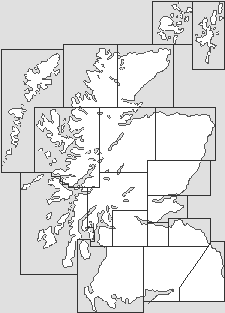 George II Half-Crown Coin, 1746 Note About Image Copyright |
George II lived from 10 November 1683 to 25 October 1760 and was King of Great Britain and Ireland from 11 June 1727 until his death. He also served as Duke of Brunswick-Lüneburg (Hanover) and Archtreasurer and Prince-Elector of the Holy Roman Empire. The wider picture in Scotland at the time is set out in our Historical Timeline.
Born Duke Georg August of Hanover, George was the last British Monarch to be born outside of Britain. As Prince of Wales he became renowned for his arguments with his father George I. And as George II he followed in his father's footsteps, in terms both of his very poor relationship with his eldest son, Frederick, Prince of Wales, and in leaving the day-to-day running of the Government in the hands of Sir Robert Walpole, effectively his Prime Minister.
As Prince of Wales, George had taken every opportunity to undermine the policies of his father George I. Whether this was connected with George I continuing to keep his ex-wife (the younger George's mother) imprisoned in a German castle is unclear. At the Christening of one of the Prince of Wales' children in 1717 the two actually fought over who should be named as godparents. Afterwards George, Prince of Wales was temporarily imprisoned by the King, before being banished from the main Royal Palaces and banned from public events.
The coronation of George II was held at Westminster Abbey on 4 October 1727. George was inclined to sack Sir Robert Walpole as, in effect, Prime Minister, primarily because he had served George I; but was persuaded by his wife, Queen Caroline, that the alternative candidate, Spencer Compton, was not up to the job. Sir Robert repaid George II for his reappointment by securing for him a very generous settlement of £800,000 per year from the Civil List, the means by which the monarchy was (and is) funded.
In 1737 relations between George II and his son Frederick, Prince of Wales, became so bad that the latter and his family were banished from the Royal Court. George had apparently even considered consigning Frederick to the colonies. And on 20 November 1737, Queen Caroline died.
From 1739, and against the advice of Sir Robert Walpole, George involved Britain in what was to become the War of Austrian Succession. Walpole retired in 1742, with power falling to Sir Spencer Crompton, 1st Earl of Wilmington; to Lord Carteret and to Henry Pelham. George II personally led the British Army in the Battle of Dettingen in 1743 (becoming the last British monarch to do so): but in Britain, public opinion increasingly thought that British interests were being overlooked to further George's Hanoverian interests.
It should have been little surprise that George II's French opponents should once again play the Jacobite card in an effort either to replace him or, at least, to severely distract him. In 1744 they therefore gathered an invasion fleet to carry an army which, with Charles Edward Stuart or the "Young Pretender" at its head would march on London and take the throne from the Hanoverians. In the event the weather intervened (as it had so often before in defence of Britain) and the French invasion did not proceed. Charles Edward Stuart took it upon himself to succeed where the might of France could not, and launched what became the '45, the 1745 uprising. Starting at Glenfinnan on 19 August 1745, with only a few companions and no money, arms or troops, Charles rapidly built up momentum, and had reached Derby, only 150 miles from London, by 4 December 1745. Had the Jacobites only known it, little resistance lay between them and the capital, Welsh Jacobites were rising in support, and George II and his court were in panic, reportedly packing barges on the Thames with all their belongings in preparation for a flight back to Hanover.
But instead of advancing on London, the Jacobites retreated north, and the 1745 uprising ended in disaster for the Jacobites on 16 April 1746 at the Battle of Culloden. Government forces at the Battle were led by George's 25 year old son, Augustus, Duke of Cumberland: better known to many as "Butcher Cumberland" for the actions of his troops after Culloden and in the subsequent suppression of the whole Highland way of life. The Young Pretender eventually escaped back to France, but this was to be the final serious Jacobite challenge for the British crown.
George II played little part in affairs of state during the last 15 years of his reign. He died on 25 October 1760 and was buried in Westminster Abbey. Frederick, Prince of Wales, had died in 1751, so George II was succeeded by his 22 year-old grandson, George William Frederick, who became George III.
